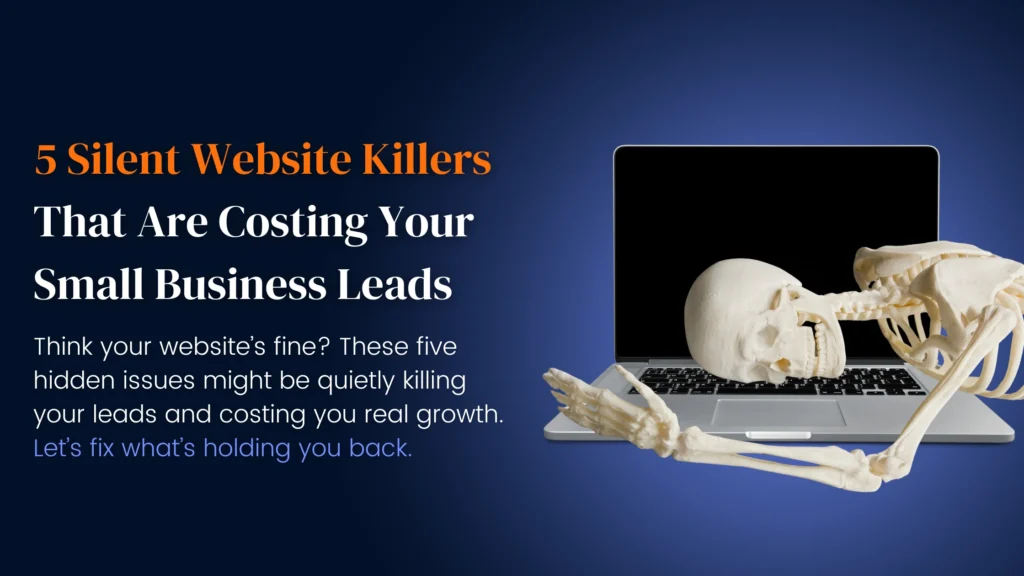So you have a brand new website but it is not meeting your traffic and conversion expectations or an older website that isn’t performing any longer. There are several reasons this can happen but one of the most common reasons is a failed web design. How does this happen, especially on a new website? And most importantly, why does it matter to your business’ bottom line? Here we discuss web design fails and what you can do to fix them (when possible).
Visually overwhelming
The old cliché, “less is more” is never more applicable than to web design. If your website is overloaded with animation and bold colors it could be an immediate turnoff to visitors. When this happens, the visitor may form an immediate opinion that the website – and by default – the business, is not professional. The visitor may bounce and keep searching through your competitors until they find a design that projects a well-thought-out, professional image.
How to fix it: Choose a branding palette that is coordinated but memorable. Be judicious when applying animation to features – animation should complement the design, not detract from it. When in doubt, keep things simple. Always remember that you have about three seconds to hook a potential customer. Visual turn-offs result in high bounce rates.
Don’t spend a dime on a new website until you can answer these questions >>
Outdated design
An outdated web design can speak volumes to a potential customer, especially if your competitor has an updated design. If you still have a website that has a page on a background, it can send the message that you are not as invested in the success of your business as the next guy. I know it seems silly and unfair! But think of it in the same terms as an interview. If an applicant shows up to an interview in a flannel shirt and ripped jeans and another applicant comes to an interview dressed in a business suit, which one are you going to assume is a better fit for your organization? Of course, you could be totally wrong in your assumptions! Flannel shirt and torn jeans guy may be way more qualified, but he didn’t present as solid of a first impression as business suit guy (who may be a terrible fit for the position!). Unfair though it may be, this concept absolutely applies to web design. First impressions count SO much as it pertains to websites – now more than ever because more than half of mobile searches take place on a mobile device.
How to fix it: If your website is a few years old, it will be difficult to fix an outdated design without a design overhaul. This may seem extreme, but as web developers we have found that a redesign is a great opportunity for businesses to update their story, products and services, branding, and messaging. If your website is outdated, there is a good chance that the information it provides is outdated too.
Life of the party, or complete dud — rate your website’s personality >>
Mobile presentation
Speaking of mobile devices, how does your website render on a Smartphone? Do the proportions and design adjust for mobile screens? Is the layout easy to understand and navigate? Does the website load quickly and offer a superior user experience? If not, your web design is failing your business.
How to fix it: Double check how your website renders on a mobile device. Does it provide a solid user experience that gives your prospective customer what they need, when they need it? If not, enlist a professional to improve your website’s mobile experience and presence.
5 Signs your website is old and what to do about it >>
Navigation contact information
In this digital day and age of immediate internet gratification, less is more when it comes to navigation. If you still have a website that is unnecessarily bulky when it comes to web pages, your website is not providing a solid user experience. By the same measure, if you have a contact page that does not have a contact form or email links that don’t work, your potential customer will not be impressed.
How to fix it: Take the time to map out your existing navigation against your competitors and what your future customer actually needs from you. Get rid of anything that does not serve the precise intent of your buyer. Ideally, you don’t want to provide every single piece of information about your products and services. You need to strike a balance between providing enough information for the visitor to want to do business with you, but not so much that they won’t pick up the phone for details. Also, make sure that your contact page has an easy-to-use contact form that works. There is no sense in having a website if your potential customer can’t have a quick and easy way to reach out to you.
Imagery
As we’ve mentioned before, social media – specifically Instagram – has greatly influenced web design when it comes to imagery. There used to be a day when developers would get away with cell-phone and stock images hastily formatted on a homepage. Those days are gone. After scrolling through visually captivating social media platforms throughout the day, visitors expect to be wowed by your imagery. Images need to tell a story, be plentiful, and be professional.
How to fix it: If your images are not on-brand, original, and tell a story, your web design is in trouble. Ideally, professional images of your business, your products, your services, and your staff formatted in a way that tells your business’ story culminate in a web design that will keep your visitor engaged.
Content structure
Content structure and web design go hand in hand. In fact, our web developer, Cassia, doesn’t create a design until she sees what content she has to work with. Once she has a solid grasp of the type of content the website will provide, she is able to formulate a design that delivers content in a way that creates the best possible user experience, provides for the best optimization, and speaks directly to the intended audience.
How to fix it: Look at your website content – specifically your homepage content – as if you were a potential customer. Does your content give your prospect the information they need, when they need it? Don’t be afraid to cut content that does not meet your visitor’s expectations, and don’t be afraid to move less relevant content away from the homepage to other pages on your website. Also remember that depending on what your visitor is looking for, they may enter your website through other pages before the homepage. Make sure that sub-navigation copy is on point, tight, and provides answers to questions your future customer is asking.




